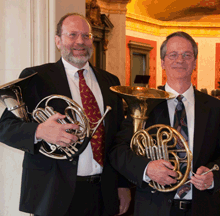
Treats and Tricks: Chamber Orchestra Program Fits the Season
A little Harvard, a little Homer (Simpson) and a lot of music
director Mischa Santora went into the Cincinnati Chamber Orchestra’s
“Pulcinella” by Igor Stravinsky Sunday afternoon at Memorial Hall.

Add WCPO-TV sportscaster Dennis Janson, who acted as narrator for “Pulcinella,” and you had an alternative to the Bengals game that deserves an encore. Fortunately it will get one when the program repeats Nov. 22 at Anderson Center in Anderson Township.
Santora took the Suite from “Pulcinella,” added excerpts from the original 1922 ballet music and with a little help from an Ivy League friend, come up with a narration. Janson adlibbed a bit, complete with Russian accent. That, in combination with the CCO’s punchy playing, gave it something for everyone -- appropriately so, since the Italian commedia dell’arte, from which “Pulcinella” derives, was what entertained the ordinary folks of Naples, Italy five and six centuries ago, and became what know as Punch and Judy.
Janson introduced each musical portion with comments about Pulcinella, “burlesque representative of the servant class,” who had a way with the girls, a gift for mimicry and was “the Homer Simpson of his time,” i.e. “intelligent in portraying the less intelligent aspects of life.” It fit perfectly with Stravinsky’s mock-serious, lollipop-bright music, which included the bustling, street scene Overture, dreamy Serenata, playful Scherzino, short, staccato Toccata and the Vivo, with trombone slides courtesy of Cristian Ganicenco. The more sober Minuetto finale paid tribute to commedia dell’arte, which has inspired creative artists ever since, from Pablo Picasso and Prokofiev to the Marx Brothers, Santora noted.
“Pulcinella” was only a part of the CCO lineup, which also included the Concerto for Two Horns attributed to Haydn and Argentine composer Alberto Ginastera’s 1953 “Varaciones Concertantes,” which starred just about everybody in the CCO.
Attributed? “Haydn absolutely did not write this concerto,” Santora told the audience. Both scholarly opinion and stylistic analysis agree, he said, but still the mystery remains (a touch of spookiness for the spooky season?). CCO French hornists Steven Gross and Randy Gardner gave it as direct and bright a performance as the sunny autumn afternoon. The instruments were equal partners, sharing its virtuosic exertions and mellifluous, melodic moments, as in the Adagio Romance. There were sounds of the hunt in the bobbing finale, which earned plaudits from the crowd.
Ginastera’s “Variaciones” echoed what has been a banner autumn for Ginastera in Cincinnati, where his music has been heard on several concerts (the Cincinnati Symphony’s “Estancia” earlier this month being one). It is one of the masterworks for chamber orchestra, and well matched to the talents of the CCO. There are 12 movements, each highlighting an instrument or instruments of the orchestra.
Not overtly “Latin,” it nevertheless uses
harmonies derived from the open strings of the guitar and Argentine dance and
folk rhythms. Cellist Patrick Binford
led off with the reflective theme, accompanied by harpist Gillian Benet
Sella. Violist Heidi Yenney shone in one
of the great solo moments for viola, fielding a big, dramatic sound and some
ethereal harmonies with the winds.
Bassist Deborah Taylor (speaking of neglected instruments) was a
standout in the reprise of the theme near the end, not to mention clarinetist
John Kurokawa, concertmaster Anna Reider (violin), bassoonist Hugh Michie,
oboist Christopher Philpotts and French hornist Tom Sherwood in their solo
spots. The final movement, a rondo with
elements of Argentine malambo and Stravinsky’s “Rite of Spring,” made a
pounding, exhilarating conclusion.
(first published in the Cincinnati Enquirer October 19, 2009)